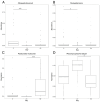Determining the Effect of Varied Proportions of Cohort Administered Tulathromycin at Arrival on Nasopharyngeal Microbiota and Performance Characteristics in Yearling Steers in the First 56 Days on Feed
- PMID: 39770715
- PMCID: PMC11677586
- DOI: 10.3390/microorganisms12122512
Determining the Effect of Varied Proportions of Cohort Administered Tulathromycin at Arrival on Nasopharyngeal Microbiota and Performance Characteristics in Yearling Steers in the First 56 Days on Feed
Abstract
Metaphylaxis or treating the entire population of cattle at arrival with an antimicrobial has been studied extensively in the cattle industry; however, little information is available on the impacts of treating only a proportion of the population with antimicrobials at arrival. The study objective was to determine potential associations between the proportion of animals in a pen treated with antimicrobial therapy with pen performance and nasopharyngeal microbiome. Yearling steers (n = 160) were randomly allocated to study pens (n = 40) and pens were systematically randomized to one of two antimicrobial treatments (META: all four head received tulathromycin; MIXED: two of four head randomly selected to receive tulathromycin). The study was conducted in conjunction with an essential oil feeding trial. Deep nasal pharyngeal (DNP) swabs were collected from every steer at Days 0, 14, 28, and 56. All DNP swabs were individually cultured for Pasteurella multocida and Mannheimia haemolytica. Samples of DNA were extracted from DNP swabs, pooled by pen, and analyzed by metagenomic shotgun sequencing to compare nasopharyngeal microbiome composition and quantity of resistance genes between test groups. Neither antimicrobial nor essential oil treatment groups had any significant associations with performance or DNP microbiome. Sampling day was significantly associated with alpha and beta diversity at the species level. Shannon's diversity and Inverse Simpson diversity were significantly lower on Day 14 versus both Day 0 and Day 56. These data indicated a shift in microbial populations across study days; however, the microbiome diversity and relative abundance were not significantly different between antimicrobial treatment groups.
Keywords: bovine respiratory disease; growth performance; nasal microbiota; tulathromycin.
Conflict of interest statement
The authors declare no conflicts of interest.
Figures





Similar articles
-
Association between respiratory disease pathogens in calves near feedlot arrival with treatment for bovine respiratory disease and subsequent antimicrobial resistance status.Front Vet Sci. 2024 Jul 23;11:1416436. doi: 10.3389/fvets.2024.1416436. eCollection 2024. Front Vet Sci. 2024. PMID: 39109351 Free PMC article.
-
Antimicrobial Metaphylaxis and its Impact on Health, Performance, Antimicrobial Resistance, and Contextual Antimicrobial Use in High-Risk Beef Stocker Calves.J Anim Sci. 2024 Jan 3;102:skad417. doi: 10.1093/jas/skad417. J Anim Sci. 2024. PMID: 38126883 Free PMC article.
-
The prevalence and antimicrobial resistance of respiratory pathogens isolated from feedlot cattle in Canada.Front Microbiol. 2025 Jan 28;16:1497402. doi: 10.3389/fmicb.2025.1497402. eCollection 2025. Front Microbiol. 2025. PMID: 39935643 Free PMC article.
-
Tulathromycin metaphylaxis increases nasopharyngeal isolation of multidrug resistant Mannheimia haemolytica in stocker heifers.Front Vet Sci. 2023 Nov 20;10:1256997. doi: 10.3389/fvets.2023.1256997. eCollection 2023. Front Vet Sci. 2023. PMID: 38053814 Free PMC article.
-
Investigating Effects of Tulathromycin Metaphylaxis on the Fecal Resistome and Microbiome of Commercial Feedlot Cattle Early in the Feeding Period.Front Microbiol. 2018 Jul 30;9:1715. doi: 10.3389/fmicb.2018.01715. eCollection 2018. Front Microbiol. 2018. PMID: 30105011 Free PMC article.
References
-
- O’Connor A.M., Hu D., Totton S.C., Scott N., Winder C.B., Wang B., Wang C., Glanville J., Wood H., White B., et al. A systematic review and network meta-analysis of injectable antimicrobial options for the control of bovine respiratory disease in the first 45 days post arrival at the feed yard. Anim. Health Res. Rev. 2019;20:163–181. doi: 10.1017/S1466252320000031. - DOI - PubMed
-
- Word A.B., Wickersham T.A., Trubenbach L.A., Mays G.B., Sawyer J.E. Effects of metaphylaxis on production responses and total antimicrobial use in high-risk beef calves. Appl. Anim. Sci. 2020;36:265–270. doi: 10.15232/aas.2019-01914. - DOI
LinkOut - more resources
Full Text Sources
Molecular Biology Databases

